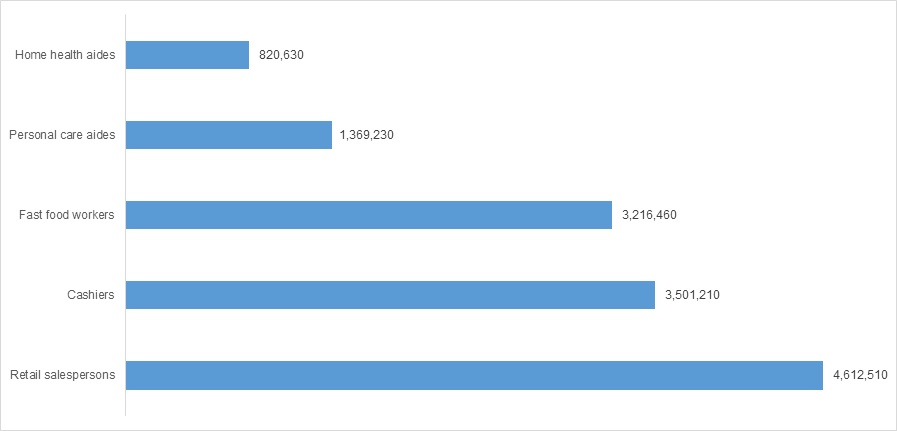 Shortage of paid care workers – a growing problem, not well-quantified by region. As AARP predicted in 2013, by the time the boomers arrive in their 80’s, just nine years from now, there would be a population deficit of prospective care providers aged 46-64 – the caregiver support ratio (CSR). But perhaps the more intriguing question – where are the workers who could, should, or would provide care? In a study released in December 2015, the U.S. Bureau of Labor Statistics (BLS) stated that the compound annual growth rate for home care services, particularly personal care aides, between 2014 and 2024 would be nearly five percent, the highest among all industries. Compare the number of workers that provide direct care (for example, personal care aides) to retail – these jobs are low-paying at approximately $11/hour and most would say the work is physically more difficult than other low-paying categories. And tech-enabling the care, while streamlining sourcing and tracking, does not close the available labor gap.
Shortage of paid care workers – a growing problem, not well-quantified by region. As AARP predicted in 2013, by the time the boomers arrive in their 80’s, just nine years from now, there would be a population deficit of prospective care providers aged 46-64 – the caregiver support ratio (CSR). But perhaps the more intriguing question – where are the workers who could, should, or would provide care? In a study released in December 2015, the U.S. Bureau of Labor Statistics (BLS) stated that the compound annual growth rate for home care services, particularly personal care aides, between 2014 and 2024 would be nearly five percent, the highest among all industries. Compare the number of workers that provide direct care (for example, personal care aides) to retail – these jobs are low-paying at approximately $11/hour and most would say the work is physically more difficult than other low-paying categories. And tech-enabling the care, while streamlining sourcing and tracking, does not close the available labor gap.
What is that gap – and is it well-understood? Take a closer look at the BLS graph, for the official worker counts home care aides and home health aides, the numbers in each are not encouraging:

What is the actual ratio of prospective clients to available workers – by geography? The only way to evaluate that gap is examine the individual county data from the census, comparing the population aged 80+, which is the prospective client base, to actual workers in care delivery job codes. The highest number of prospective clients as compared to the number of workers in individual job codes is the Paid Caregiver Support Ratio – or PCSR. First examine the data from the 2015 blog post Stranded by Geography, which was based on the age ratio of prospective caregivers to baby boomers aged 80+. Now look at this county data about personal care aide workers (see attached PDFs), which shows a gap between the prospective number of aged 80+ seniors per care worker. This gap is very noticeable in Florida and New Jersey. Future postings will examine other job categories that provide care, including home health aides, examining the gap in those categories.
| Attachment | Size |
|---|---|
| 374.96 KB | |
| 1.12 MB |
from Tips For Aging In Place https://www.ageinplacetech.com/blog/finding-paid-care-introducing-paid-caregiver-support-ratio-pcsr
No comments:
Post a Comment
Note: Only a member of this blog may post a comment.